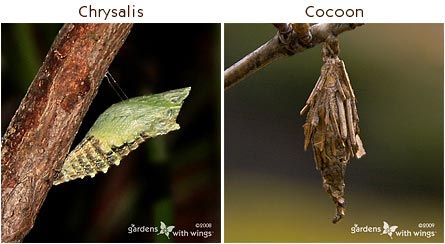I’m confused – what exactly is a chrysalis, and how is it different from a cocoon?

Chrysalises and cocoons both protect developing butterflies and moths, but they’re different structures. A chrysalis is the hardened skin of a butterfly pupa, while a moth caterpillar spins a silken cocoon. For more information, see our article: The Fascinating Difference Between a Chrysalis and a Cocoon.
Where can I find chrysalises in the wild?
Finding a chrysalis is like discovering a hidden treasure! These camouflaged wonders can be found in all sorts of places. Start by checking common spots like the undersides of leaves, stems, fences, walls, and garden furniture. Then, expand your search to less obvious locations like window screens, garden structures, and sheltered corners of your yard. They can even be on the ground! Want to learn the secrets to becoming a chrysalis detective? Our guide has all the details: How to Find Chrysalises.
How do chrysalises survive the winter?
Many butterflies, like swallowtails, actually overwinter as a chrysalis! They’re incredibly resilient. Some species attach themselves securely to twigs with a silken harness, which helps them withstand winter winds. Others might be found nestled amongst leaf litter, safe and sound until spring arrives. Want to learn more about how chrysalises survive the winter? Check out our article: The Amazing Ways Butterflies Survive Winter.
Do Butterflies move in the chrysalis stage?
Yes, although they are not mobile. They do have the ability to wiggle and some also make noise as a defense mechanism to frighten away possible predators.







